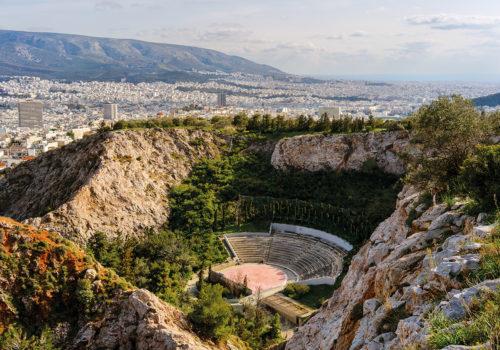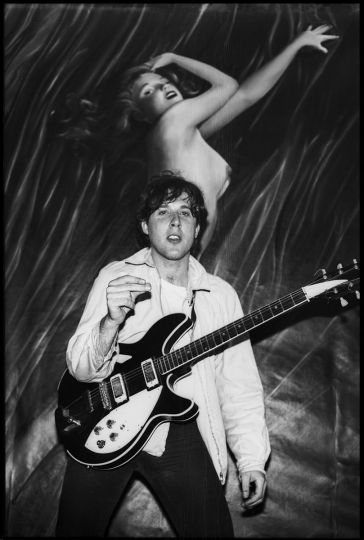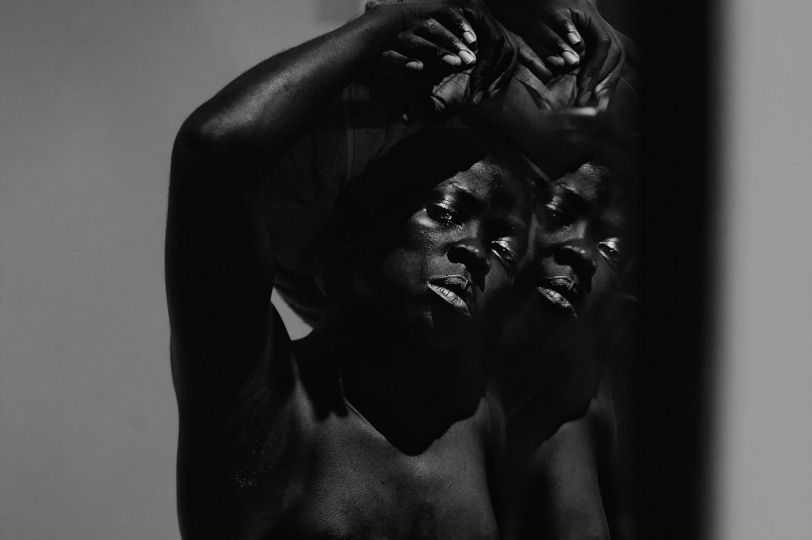Athênai, In Search of Home expands Niko J. Kallianiotis’ first monograph America in a Trance, and the work produced in Pennsylvania, which for two decades became his second home. If ‘America in a Trance’ was about his departure from Athens and the exploration of a new personal and social condition, ‘Athênai, In Search of Home’ is about coming back to his roots, eager to assimilate within a place that over the years grew to be foreign but at the same time maintained its layers of familiarity.
The photographs explore through the metro areas of Athens within an utterly diverse setting, all the way to the periphery and within a more rural and industrial stage that is vital to the character and condition of Athens. Throughout the years the city and the surrounding territories have experienced their share of socio-economic struggles and topographic transformations that have altered its identity. The city of Athens in Kallianiotis’ photographs is elliptically delineated as a vibrant environment that binds together luxury and social inequality. The photographer depicts a city in which the temporal and the spatial elements often clash with each other, while conducting his research for a home that has changed over the years as much as he did.
Athens In Plural – Essay by Hercules Papaioannou – Curator, Thessaloniki Museum of Photography
Since antiquity, the city embodied the organized social life, the commercial and spiritual center where goods and ideas circulated. Through the Industrial Revolution of the 18th century, its population became more and more dense, fueled by urbanization currents, in the hopes for a better life, away from feudal slavery. For the next two centuries, the city became the cradle where reformations were hatched, and innovations conceived. As a result, the megapolis emerged, exuding an ecumenical aura, while failing to meet the basic condition of a decent life, or even housing. The year 2008 marked a milestone for the accelerated city growth: for the first time in human history, more people lived in urban centers than the countryside. If modern life is inextricably intertwined with the urban phenomenon, it seems logical for photography, a par excellence modern medium, to delineate its image. An eminent example was William Klein, who distilled in separate editions the scent of cities such as New York (1958), Rome (1959), Moscow (1964), Tokyo (1964). However, the one who profoundly radiographed an urban territory, was Eugéne Atget. Influenced by French literature and the radical renovations of Paris in the second half of the 19th century, he devoted himself to its depiction for more than three decades (1890-1927), composing an innovative, yet nostalgic work, beyond local or national boundaries.
Since then, many photographers urged to capture the portrait of a city. Niko J. Kallianiotis’ new work on Athens, is looking for a place along this line. Having immigrated to America at a young age in 1998, he was trained in the country’s vast photographic horizon. His first monograph America in a Trance, (2018) was a melancholic journey of his foster homeland, the once prosperous industrial region of Pennsylvania. In his new series Athênai, In Search of Home, Niko J. Kallianiotis surveys, conversely, his birth city after his return. In a possibly inevitable manner, he photographs his first homeland under the artistic influence of the second. The city of his childhood surely did not exist as he once left it. In its place, he found a peculiarly charming and unpredictably turbulent capital, on the threshold between East and West, that doesn’t easily become anybody’s Ithaca. In his photographs, Kallianiotis seems to rediscover it anew, rather than interacting with the selective ambiguities of memory.
Relying on both precise observation and intuition, he perceived Athens as a multidimensional phenomenon: as a city that has left an indelible mark on the history of civilization, in which the persistent immobility of ancient fragments while everything around changes feeds the impression that one wanders among centurial gaps. Kallianiotis also overviews contemporary temples, cultural or consumerist, such as the renovated National Gallery or the shopping center in Maroussi, outlining this way the city’s 21st century profile. Raw views of life at street level emerge from his work, validating as much as overturning preconceived judgments. By discerning also subtle correlations, he reveals profoundly the city’s spirit, while simultaneously embossing the difference between the heart and the limbs of the Athenian body, the vital and the decadent, the constantly new and the decidedly decaying. He traverses through multicultural Athens, discovering the city’s latent immigrant enclaves, such as the Kurdish club in Lavrio or the mirror-filled Islamic barber shop in Kallithea, where the American flag serves as an apron. Kallianiotis’ Athens is eventually of plural number (as its older name implied), as he traces many of it in the heart of Attica.
To achieve this, he traveled tirelessly around Athens, to each cardinal direction: from the views mesmerizing with historicity or sparkling with contemporary glaze to its outskirts at the under-construction buildings of Kamatero, the stream fair of Schisto, or the refugee houses of Elefsina, where everything is weighed upon the measure of necessity and life goes on with the bare minimum. He proceeds even further, where recent wildfires have burned suburban forests to ashes and reclusive residences highlight the arbitrarily vast human penetration in nature and the severity of the climate change. This spatial wandering also acquainted Kallianiotis with the lopsided times of the city: the pressuring rhythm of the daily strives, the idle tourist gait, the pulse of parades and demonstrations, the frozen historical time, the suspended one of the homeless. That is implied in the luminous valley within a shadowy urbanscape at Panepistimiou Street, where a homeless man lies on the pavement, lingering on the border between light and darkness. People roam his photographs in various ways: they sometimes dominate the foreground in fervent snapshots that favor circumstantial coexistence. Other times, they recede to the middleground, in relationships carefully weighted with their surroundings or they fade in the background as inert contributors. And it becomes difficult to decide, in this alternating repertoire of urban views, whether they shape the environment or instead, they are being shaped by it.
Throughout his wandering, Kallianiotis meticulously digs through the dense forest of the urban signs; in Elefsina he discerns the laurel-crowned Aeschylus coexisting with commercial inscriptions. In Megara, at a grassy basketball court, he locates a mutilated replica of Myron’s Discobolus. In Aspropyrgos, at a residence under construction, the imitations of ancient columns establish the personal hearth on a collective ideal. The closed airport of Elliniko, once a connecting gateway of Athens to every corner of the earth, became a refraining space for refugees. Kallianiotis also harvests events that present the modern city as a generator of paranoia: such is the case of the young woman sitting on the exterior side of a typical Athenian balcony, displaying an unnaturally calm attraction to void. Or the refugee woman who crosses Kotzia Square, holding a doll by the neck, protecting forcefully the lifeless body, in a poignant hint of potential losses. He also exchanges haughty looks with a bus driver, next to whom a painted helmet emerges with the epic inscription «Molon Lave” (Μολών λαβέ). And he is looking for surprising layers of possible meanings, as when observing an arcade at Omonia Square where people gathered in the lower level remind of lives buried inside the urban labyrinth.
His photographs often seem to be permeated by an electric current, a subtle intensity, an element of his character denoted in the use of color, unexpected features, and urban transitions (real or conceptual). A careful reader of the qualities of form and light, Kallianiotis explores intermediate positions between deadpan topography and volatile street photography, often imbuing an austere frame with unexpected incidents. Form after all sometimes proposes meanings by itself: the column on Stadiou Street dissecting the frame inserts history in an imposing way into the present, while the statue of Kolokotronis on the one side is vaguely pointing towards a building’s skeleton on the other, connecting the course of the Greek revolution with the architectural surplus value. And the jungle of concrete emerges in distant, almost abstract views, such as the one in Tourkovounia, like a vast, real estate business. Kallianiotis’ robust look incorporates the city view in the architectural structure of the photograph, as a scenic stage where significant and insignificant stories unfold. And he confirms that one of the greatest contributions of photography to modern history (not just art history) is its obsession to give meaning to the vernacular, transcending overarching hierarchies.
In his oeuvre, all kinds of images converse sideways with the social domain: from the anti-vaccination protests in Omonia Square, to courtyards with laundry layouts in Perama, in microcosms where reality and idealization collide; or the oversized graffiti female figure that gets trapped between pillars and a question mark. In another, almost monochromatic scene, an image of the old Athens on the side of a parked truck, creates a muted dialogue with its modern self. Elsewhere, memorabilia and experiences are loaded at bus stations, set to travel to the depths of the Balkans, under the gaze of a Homeric figure over an adjacent, dilapidated building, pointing out departure and return as a diachronic and cross-cultural cycle. At the Hilton, on the other hand, a historical symbol of local modernity, the purity of form and abstract geometry function as a metaphor for sophistication and wealth. And the bizarre, fermented with both elaborated judgment and absurd discrimination, rises as a new normality in a world exuberant in visual signs, but often empty of content.
The adept handling of the coincidental, points out another strange, existential solitude: the young man across the ancient columns of the Olympian Zeus temple, shakes something off his body, as if releasing himself from an importunate disturbance; a man plays peacefully his flute in the park, disregarding the heavy snowfall. Static frontal portraits in Magoula and St. Barbara counterpoint to scenes of protest and sport fanaticism, or to the police squad that guards a commercial building, wrapped as a gift. Violence, however, also lurks in the empty landscape marked as a checkpoint, where austere vertical and diagonal lines along with the surveillance camera, escalate the sense of control, or in a Mercedes with a sunken top that is monumentally erected on top of a container. Additionally, it lurks in the police bus separating the neutrally-colored, Grand Bretagne elite hotel from the saturated red flag of the Greek Communist Party.
Kallianiotis converses openly with History, from the representation of the naval battle of Salamis at a Pireaus warehouse, to the narrow rebetis bridge, again in Piraeus. At the Kaisariani shooting range, wreaths and red ribbons on tree trunks symbolize those who stood against the Nazis, while the wall on Amalias Avenue still bears bullet traces of the December Events (1944), as old and modern civil wars signify the fate that man does not want or cannot avoid. In other photos, the religious sentiment is palpable: in a church mural, Christ performs a miracle before the astonished gazes of the portrayed faithful, above vacant chairs. In a night scene in Koropi, the imperative request for repentance entangles ominously with the railing shadows.
As a mature snap shooter, he crucially combines the ephemeral with the permanent, noting the anonymity as well as the apparent personalization, such as the mask with Botticelli’s Aphrodite at the Unknown Soldier Monument, or the man in the Royal Garden who has tattooed the ex-king’s name and crown on his body. At times, a comment is obvious, such as the stadium geometry that seems to enclose a person in a wheelchair. In other cases, it is upon the spectator to pick his path in order to attempt an interpretation: Like in Perissos, where the naked mannequins of a shop window inspect an excavated road, resembling metaphorically the trenches of an undeclared war; or the scene in Mikrolimano where the decorated facade of a bistro stands across an unclassified disorderly landscape.
Nevertheless, if Kallianiotis’ work is animated by contemporary street photography, what are its givens in the 21st century? The practice that contributed to the understanding of the metropolitan condition, to social photography and to the photographic art, revealing the inequalities and instabilities of the system, received fiery criticism for the transcendence of individuality. The criticism is founded, but the situation is more complex: such a possible exclusion favors the mirroring of society defined by power (and official art as part of it) and its toxic, media appendages. All this at a time when almost everything shrinks into a superficial communication and the city becomes an image in itself, wearing a fake luster, under which commotion seethes. Perhaps a new pictorial ethos should be sought in street photography, tested on the edge between public privacy and collective self-examination. Julian Stallabrass, after all, while interpreting Walter Benjamin, saw the street as the home of the collective.1 A significant part of Kallianiotis photography, illustrates people in frontal view, in a non-recognizable way, or without revealing anything personal about them.
What is Athens after all? It is everything expected from the city and at the same time a serendipitous surprise, a condition constantly fluid, anarchically liberating. It is a place where macro-history, both ancient and contemporary, is fermented with micro-history, the anonymous adventure, where sophistication and trauma coexist, where local contexts blend with the universal language. And the unofficial city language slithers wall-to-wall, aggressively or tenderly, claiming excluded degrees of freedom. Kallianiotis’ Athens bears in its body every success and failure of modern Greek society, the obvious struggle traces between the domestic and the imported, the creeping violence of the economic crisis, aspects of reality that seem brutally welded, without coherence or consistent ideology. It contains in abundance contradictions and paradoxes that manifest themselves mainly as a conflict ground. Or as a deep dive from the noble “All we have is words, all we have is worlds” at the House of Letters and Arts, to the pawnshop of the Piraeus neighborhood, whose red lights seem to flicker an alarm. Perhaps such situations are common in every big city. Some of them manage to cover the scars, embellishing them successfully, soothing the atmosphere with a balance between picturesque notes, restored monuments, and contemporary architecture. In Athens, however, as Kallianiotis brilliantly depicts, the chasm is unceremoniously evident, since the city savors being both European and Balkan, Mediterranean and Oriental, cosmopolitan and a province on the edge of Europe, abrading boundaries geographical and cultural, economical and social, belonging normatively to the western context while deftly evading its rigid austerity, maintaining its ancient definition as a city-state, in both historical and contemporary terms. In this sense, Athens eludes any definite description. Unless someone is able to compose its portrait piece by piece, recognize its wild poetry, elliptically traverse its immense body and surrender himself to the city’s small, meaningful secrets, while comprehending the way that the light, in which the city bathes, interweaves with the mystery of time. It is then where Niko J. Kallianiotis’ Athênai emerge, perhaps surprisingly and unexpectedly vital, justifying the pluralism in the city’s name.
Hercules Papaioannou
Curator, Thessaloniki Museum of Photography
Niko J. Kallianiotis : Athênai, In Search of Home
Publisher, Damiani 2022
160 pages
119 Photographs
Languages English/Greek
ISBN: 9788862087827
www.damianieditore.com
website : www.nikokallianiotis.com
Instagram njkphoto
















